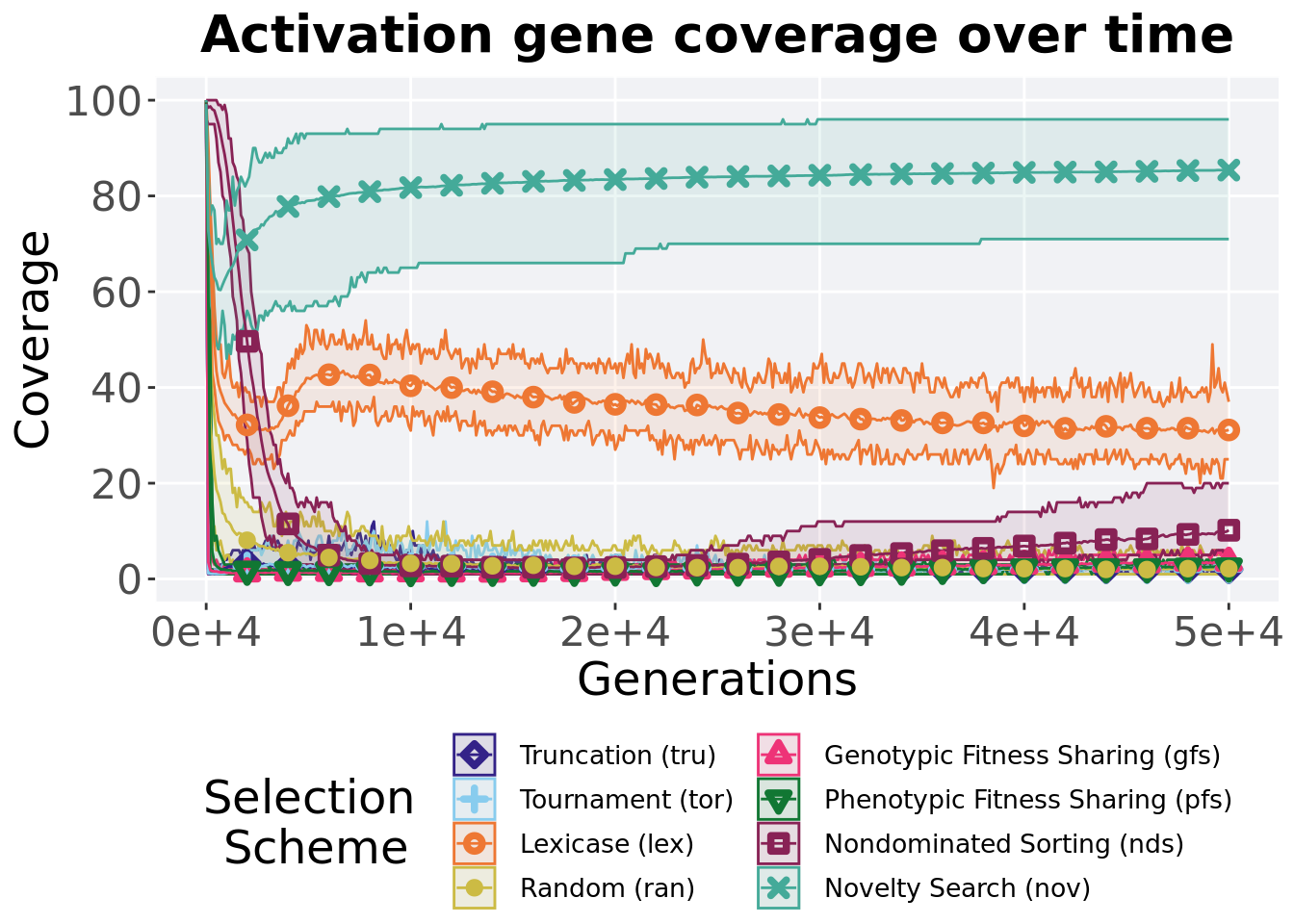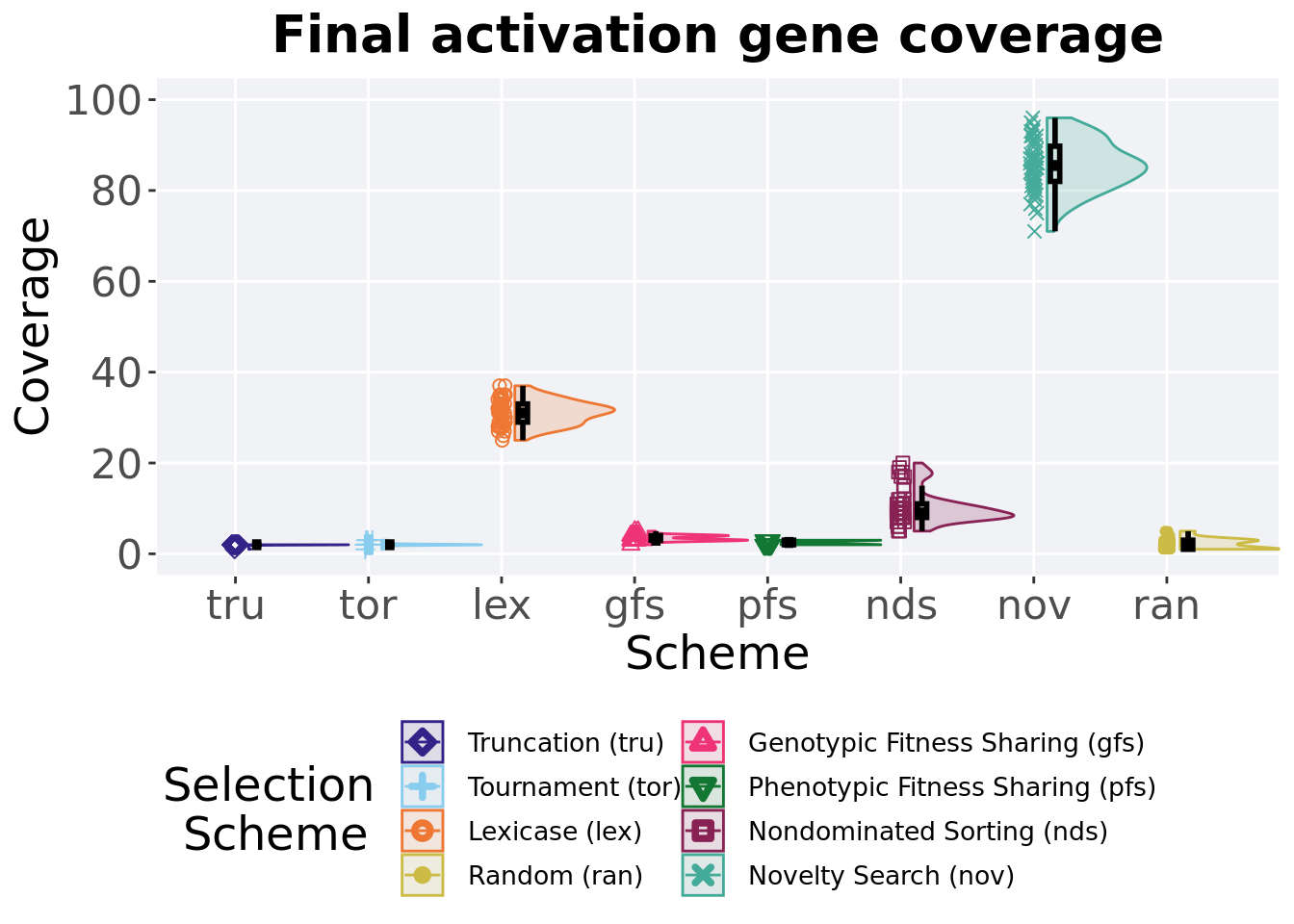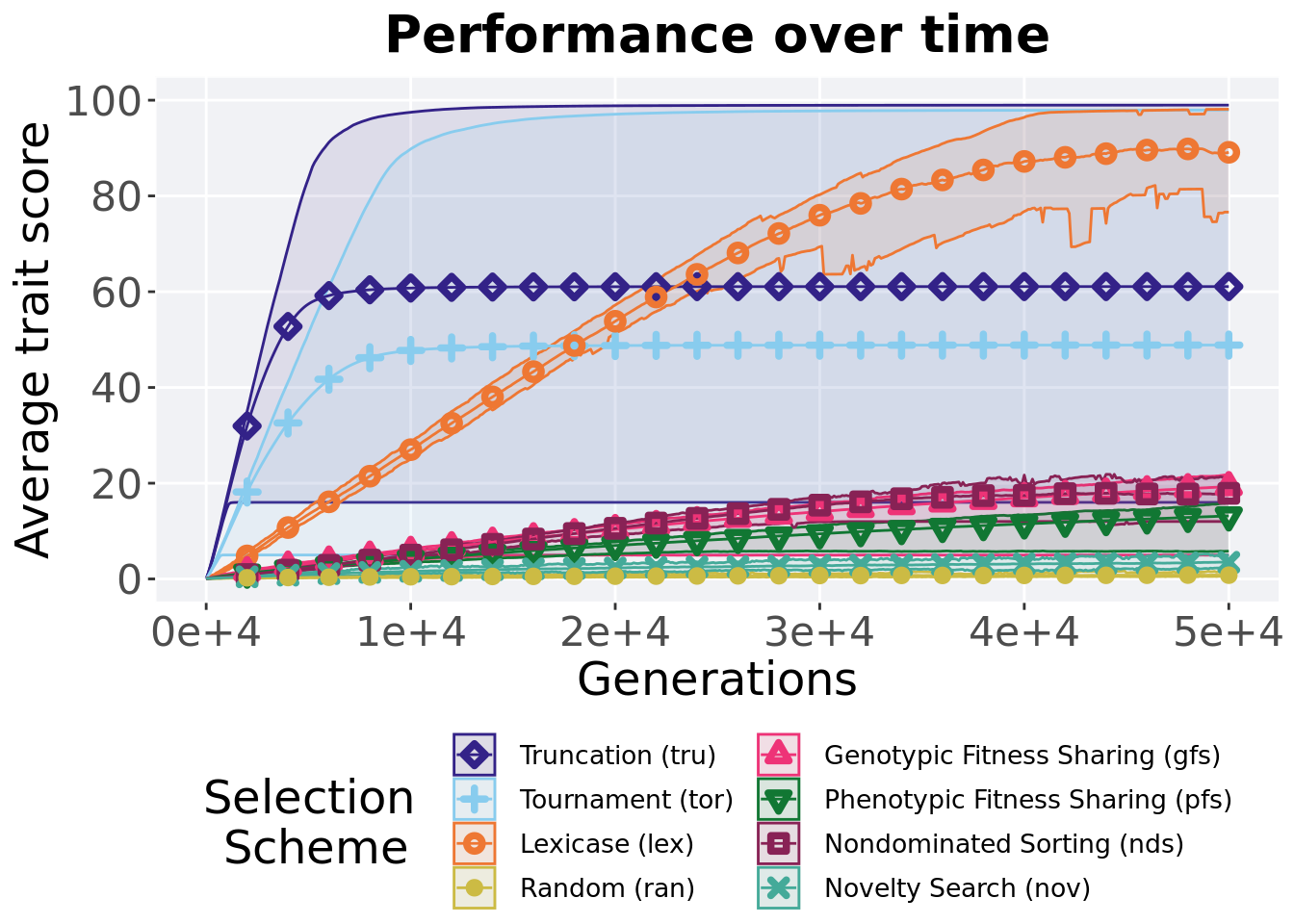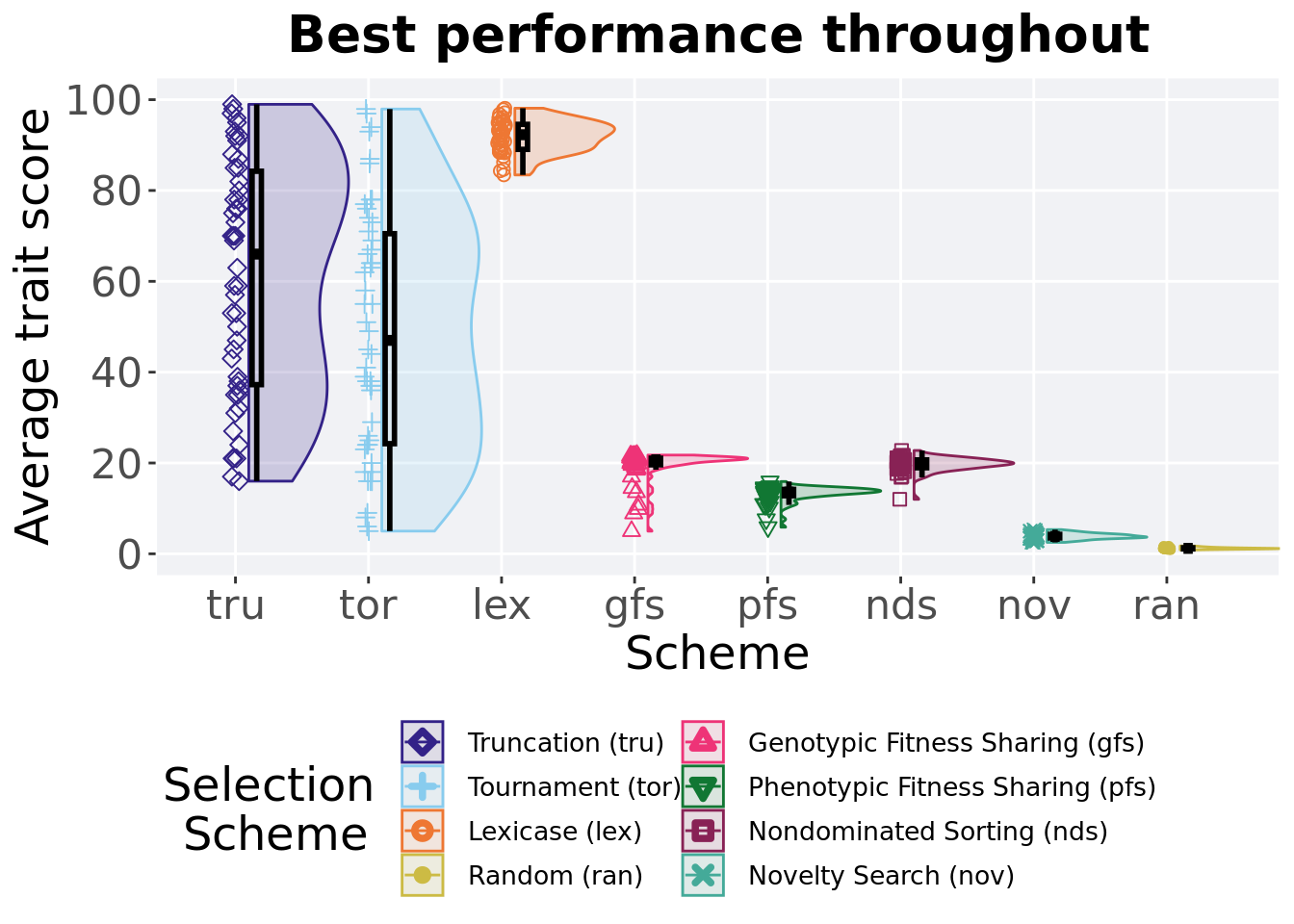Chapter 5 Multi-path exploration results
Here we present the results for best performances and activation gene coverage found by each selection scheme on the multi-path exploration diagnostic. 50 replicates are conducted for each scheme explored.
5.1 Data setup
DIR = paste(DATA_DIR,'MULTIPATH_EXPLORATION/', sep = "", collapse = NULL)
over_time_df <- read.csv(paste(DIR,'over-time.csv', sep = "", collapse = NULL), header = TRUE, stringsAsFactors = FALSE)
over_time_df$uni_str_pos = over_time_df$uni_str_pos + over_time_df$arc_acti_gene - over_time_df$overlap
over_time_df$scheme <- factor(over_time_df$scheme, levels = NAMES)
over_time_df$acro <- factor(over_time_df$acro, levels = ACRO)
best_df <- read.csv(paste(DIR,'best.csv', sep = "", collapse = NULL), header = TRUE, stringsAsFactors = FALSE)
best_df$acro <- factor(best_df$acro, levels = ACRO)5.2 Activation gene coverage over time
Activation gene coverage in a population over time. Data points on the graph is the average activation gene coverage across 50 replicates every 2000 generations. Shading comes from the best and worse coverage across 50 replicates.
lines = over_time_df %>%
group_by(scheme, gen) %>%
dplyr::summarise(
min = min(uni_str_pos),
mean = mean(uni_str_pos),
max = max(uni_str_pos)
)## `summarise()` has grouped output by 'scheme'. You can override using the
## `.groups` argument.lines$scheme <- factor(lines$scheme, levels = c('Truncation (tru)','Tournament (tor)','Lexicase (lex)','Random (ran)','Genotypic Fitness Sharing (gfs)','Phenotypic Fitness Sharing (pfs)','Nondominated Sorting (nds)','Novelty Search (nov)'))
over_time_plot = ggplot(lines, aes(x=gen, y=mean, group = scheme, fill = scheme, color = scheme, shape = scheme)) +
geom_ribbon(aes(ymin = min, ymax = max), alpha = 0.1) +
geom_line(size = 0.5) +
geom_point(data = filter(lines, gen %% 2000 == 0 & gen != 0), size = 1.5, stroke = 2.0, alpha = 1.0) +
scale_y_continuous(
name="Coverage",
limits=c(0, 100),
breaks=seq(0,100, 20),
labels=c("0", "20", "40", "60", "80", "100")
) +
scale_x_continuous(
name="Generations",
limits=c(0, 50000),
breaks=c(0, 10000, 20000, 30000, 40000, 50000),
labels=c("0e+4", "1e+4", "2e+4", "3e+4", "4e+4", "5e+4")
) +
scale_shape_manual(values=c(5,3,1,20,2,6,0,4))+
scale_colour_manual(values = c('#332288','#88CCEE','#EE7733','#CCBB44','#EE3377','#117733','#882255','#44AA99')) +
scale_fill_manual(values = c('#332288','#88CCEE','#EE7733','#CCBB44','#EE3377','#117733','#882255','#44AA99')) +
ggtitle('Activation gene coverage over time')+
p_theme +
guides(
shape=guide_legend(ncol=2, title.position = "left", title = 'Selection \nScheme'),
color=guide_legend(ncol=2, title.position = "left", title = 'Selection \nScheme'),
fill=guide_legend(ncol=2, title.position = "left", title = 'Selection \nScheme')
)
over_time_plot
5.3 Final activation gene coverage
Activation gene coverage found in the final population at 50,000 generations.
plot = filter(over_time_df, gen == 50000) %>%
ggplot(., aes(x = acro, y = uni_str_pos, color = acro, fill = acro, shape = acro)) +
geom_flat_violin(position = position_nudge(x = .1, y = 0), scale = 'width', alpha = 0.2, width = 1.5) +
geom_boxplot(color = 'black', width = .07, outlier.shape = NA, alpha = 0.0, size = 1.0, position = position_nudge(x = .16, y = 0)) +
geom_point(position = position_jitter(width = 0.03, height = 0.02), size = 2.0, alpha = 1.0) +
scale_y_continuous(
name="Coverage",
limits=c(0, 100),
breaks=seq(0,100, 20),
labels=c("0", "20", "40", "60", "80", "100")
) +
scale_x_discrete(
name="Scheme"
)+
scale_shape_manual(values=SHAPE)+
scale_colour_manual(values = cb_palette, ) +
scale_fill_manual(values = cb_palette) +
ggtitle('Final activation gene coverage')+
p_theme
plot_grid(
plot +
theme(legend.position="none"),
legend,
nrow=2,
rel_heights = c(3,1)
)
5.3.1 Stats
Summary statistics for the coverage found in the final population.
act_coverage = filter(over_time_df, gen == 50000)
act_coverage$acro = factor(act_coverage$acro, levels = c('nov','lex','nds','gfs','pfs','ran','tor','tru'))
act_coverage %>%
group_by(acro) %>%
dplyr::summarise(
count = n(),
na_cnt = sum(is.na(uni_str_pos)),
min = min(uni_str_pos, na.rm = TRUE),
median = median(uni_str_pos, na.rm = TRUE),
mean = mean(uni_str_pos, na.rm = TRUE),
max = max(uni_str_pos, na.rm = TRUE),
IQR = IQR(uni_str_pos, na.rm = TRUE)
)## # A tibble: 8 x 8
## acro count na_cnt min median mean max IQR
## <fct> <int> <int> <int> <dbl> <dbl> <int> <dbl>
## 1 nov 50 0 71 85.5 85.4 96 7.75
## 2 lex 50 0 25 31 31.1 37 4
## 3 nds 50 0 5 9 10.2 20 3
## 4 gfs 50 0 2 3 3.48 5 1
## 5 pfs 50 0 2 2.5 2.5 3 1
## 6 ran 50 0 1 2 2.16 5 2
## 7 tor 50 0 1 2 2.04 3 0
## 8 tru 50 0 1 2 1.98 2 0Kruskal–Wallis test illustrates evidence of statistical differences.
##
## Kruskal-Wallis rank sum test
##
## data: uni_str_pos by acro
## Kruskal-Wallis chi-squared = 350.25, df = 7, p-value < 2.2e-16Results for post-hoc Wilcoxon rank-sum test with a Bonferroni correction.
pairwise.wilcox.test(x = act_coverage$uni_str_pos, g = act_coverage$acro, p.adjust.method = "bonferroni",
paired = FALSE, conf.int = FALSE, alternative = 'l')##
## Pairwise comparisons using Wilcoxon rank sum test with continuity correction
##
## data: act_coverage$uni_str_pos and act_coverage$acro
##
## nov lex nds gfs pfs ran tor
## lex < 2e-16 - - - - - -
## nds < 2e-16 < 2e-16 - - - - -
## gfs < 2e-16 < 2e-16 < 2e-16 - - - -
## pfs < 2e-16 < 2e-16 < 2e-16 3.6e-10 - - -
## ran < 2e-16 < 2e-16 < 2e-16 9.4e-08 0.4 - -
## tor < 2e-16 < 2e-16 < 2e-16 < 2e-16 1.2e-05 1.0 -
## tru < 2e-16 < 2e-16 < 2e-16 < 2e-16 1.1e-07 1.0 1.0
##
## P value adjustment method: bonferroni5.4 Performance over time
Best performance in a population over time. Data points on the graph is the average performance across 50 replicates every 2000 generations. Shading comes from the best and worse performance across 50 replicates.
lines = over_time_df %>%
group_by(scheme, gen) %>%
dplyr::summarise(
min = min(pop_fit_max) / DIMENSIONALITY,
mean = mean(pop_fit_max) / DIMENSIONALITY,
max = max(pop_fit_max) / DIMENSIONALITY
)## `summarise()` has grouped output by 'scheme'. You can override using the
## `.groups` argument.lines$scheme <- factor(lines$scheme, levels = c('Truncation (tru)','Tournament (tor)','Lexicase (lex)','Random (ran)','Genotypic Fitness Sharing (gfs)','Phenotypic Fitness Sharing (pfs)','Nondominated Sorting (nds)','Novelty Search (nov)'))
over_time_plot = ggplot(lines, aes(x=gen, y=mean, group = scheme, fill = scheme, color = scheme, shape = scheme)) +
geom_ribbon(aes(ymin = min, ymax = max), alpha = 0.1) +
geom_line(size = 0.5) +
geom_point(data = filter(lines, gen %% 2000 == 0 & gen != 0), size = 1.5, stroke = 2.0, alpha = 1.0) +
scale_y_continuous(
name="Average trait score",
limits=c(0, 100),
breaks=seq(0,100, 20),
labels=c("0", "20", "40", "60", "80", "100")
) +
scale_x_continuous(
name="Generations",
limits=c(0, 50000),
breaks=c(0, 10000, 20000, 30000, 40000, 50000),
labels=c("0e+4", "1e+4", "2e+4", "3e+4", "4e+4", "5e+4")
) +
scale_shape_manual(values=c(5,3,1,20,2,6,0,4))+
scale_colour_manual(values = c('#332288','#88CCEE','#EE7733','#CCBB44','#EE3377','#117733','#882255','#44AA99')) +
scale_fill_manual(values = c('#332288','#88CCEE','#EE7733','#CCBB44','#EE3377','#117733','#882255','#44AA99')) +
ggtitle('Performance over time')+
p_theme +
guides(
shape=guide_legend(ncol=2, title.position = "left", title = 'Selection \nScheme'),
color=guide_legend(ncol=2, title.position = "left", title = 'Selection \nScheme'),
fill=guide_legend(ncol=2, title.position = "left", title = 'Selection \nScheme')
)
over_time_plot
5.5 Best performance throughout
Best performance reached throughout 50,000 generations in a population.
plot = filter(best_df, var == 'pop_fit_max') %>%
ggplot(., aes(x = acro, y = val / DIMENSIONALITY, color = acro, fill = acro, shape = acro)) +
geom_flat_violin(position = position_nudge(x = .1, y = 0), scale = 'width', alpha = 0.2, width = 1.5) +
geom_boxplot(color = 'black', width = .07, outlier.shape = NA, alpha = 0.0, size = 1.0, position = position_nudge(x = .16, y = 0)) +
geom_point(position = position_jitter(width = 0.03, height = 0.02), size = 2.0, alpha = 1.0) +
scale_y_continuous(
name="Average trait score",
limits=c(0, 100),
breaks=seq(0,100, 20),
labels=c("0", "20", "40", "60", "80", "100")
) +
scale_x_discrete(
name="Scheme"
)+
scale_shape_manual(values=SHAPE)+
scale_colour_manual(values = cb_palette, ) +
scale_fill_manual(values = cb_palette) +
ggtitle('Best performance throughout')+
p_theme
plot_grid(
plot +
theme(legend.position="none"),
legend,
nrow=2,
rel_heights = c(3,1)
)
5.5.1 Stats
Summary statistics for the best performance.
performance = filter(best_df, var == 'pop_fit_max')
performance$acro = factor(performance$acro, levels = c('lex','tru','tor','gfs','nds','pfs','nov','ran'))
performance %>%
group_by(acro) %>%
dplyr::summarise(
count = n(),
na_cnt = sum(is.na(val)),
min = min(val / DIMENSIONALITY, na.rm = TRUE),
median = median(val / DIMENSIONALITY, na.rm = TRUE),
mean = mean(val / DIMENSIONALITY, na.rm = TRUE),
max = max(val / DIMENSIONALITY, na.rm = TRUE),
IQR = IQR(val / DIMENSIONALITY, na.rm = TRUE)
)## # A tibble: 8 x 8
## acro count na_cnt min median mean max IQR
## <fct> <int> <int> <dbl> <dbl> <dbl> <dbl> <dbl>
## 1 lex 50 0 83.4 92.3 91.9 98.1 5.51
## 2 tru 50 0 16 66.0 61.1 99.0 47.0
## 3 tor 50 0 5 47.0 48.9 97.9 46.2
## 4 gfs 50 0 4.99 20.7 19.3 21.7 1.45
## 5 nds 50 0 12.0 19.9 19.7 22.8 1.72
## 6 pfs 50 0 5.87 13.6 13.2 15.9 1.39
## 7 nov 50 0 2.52 3.83 3.87 5.33 0.793
## 8 ran 50 0 0.865 1.19 1.23 1.72 0.247Kruskal–Wallis test illustrates evidence of statistical differences.
##
## Kruskal-Wallis rank sum test
##
## data: val by acro
## Kruskal-Wallis chi-squared = 356.22, df = 7, p-value < 2.2e-16Results for post-hoc Wilcoxon rank-sum test with a Bonferroni correction.
pairwise.wilcox.test(x = performance$val, g = performance$acro, p.adjust.method = "bonferroni",
paired = FALSE, conf.int = FALSE, alternative = 'l')##
## Pairwise comparisons using Wilcoxon rank sum test with continuity correction
##
## data: performance$val and performance$acro
##
## lex tru tor gfs nds pfs nov
## tru 4.4e-09 - - - - - -
## tor 1.1e-12 0.33 - - - - -
## gfs < 2e-16 2.3e-13 4.3e-07 - - - -
## nds < 2e-16 1.2e-13 6.8e-07 0.47 - - -
## pfs < 2e-16 < 2e-16 5.0e-12 2.3e-11 1.3e-15 - -
## nov < 2e-16 < 2e-16 < 2e-16 < 2e-16 < 2e-16 < 2e-16 -
## ran < 2e-16 < 2e-16 < 2e-16 < 2e-16 < 2e-16 < 2e-16 < 2e-16
##
## P value adjustment method: bonferroni